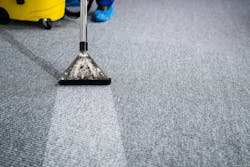The health and safety of students and staff always has been a consideration when schools choose floor coverings for their facilities. In a world coping with the hazards associated with Covid-19, education administrators must be even more vigilant about their flooring choices and how to keep surfaces clean and well-maintained.
Whether carpeting or hard flooring is the better choice for education facilities is a debate of many years standing, but there is no dispute that keeping those surfaces cleaned is a critical element in providing a healthful environment for students and staff.
“Regardless of the floor covering type, regular and effective cleaning and maintenance is essential to keep it dry and clean,” the EPA says.
Avoiding germs and disease is a prime reason for keeping educational facilities cleaned and disinfected, but the importance of those efforts has become heightened because of the devastating effect of Covid-19—3.5 million deaths worldwide, include nearly 600,000 in the United States.
Airborne transmission (exposure to respiratory droplets carrying infectious virus) is the principal way that people contract SARS-CoV-2, the virus that can lead to Covid-19, the Centers for Disease Control and Prevention (CDC) says.
“It is possible for people to be infected through contact with contaminated surfaces or objects (fomites), but the risk is generally considered to be low,” the CDC says.
Studies suggest that the risk of SARS-CoV-2 infection via the fomite (surface) transmission route is generally less than 1 in 10,000, the CDC says. Nevertheless, schools and universities should have effective cleaning programs in place for cleaning floors, carpets, and other surfaces to further minimize the risk and ward off other illnesses, too.
“Both cleaning (use of soap or detergent) and disinfection (use of a product or process designed to inactivate SARS-CoV-2) can reduce the risk of fomite transmission,” the CDC says. “Cleaning reduces the amount of soil (e.g., dirt, microbes and other organic agents, and chemicals) on surfaces, but efficacy varies by the type of cleaner used, cleaning procedure, and how well the cleaning is performed…. In addition to physical removal of SARS-CoV-2 and other microbes, surface cleaning can be expected to degrade the virus.”
Regular cleaning
The CDC recommends that for soft surfaces such as carpets and rugs, custodians should clean “using a product containing soap, detergent, or other type of cleaner appropriate for use on these surfaces.”
To substantially inactivate SARS-CoV-2 on surfaces, they “must be treated with a disinfectant product registered with the Environmental Protection Agency’s (EPA’s) List N or technology that has been shown to be effective against the virus,” the CDC says.
The EPA notes that soft and porous materials are generally not as easy to disinfect as hard and non-porous surfaces. It suggests that facilities managers consider the feasibility of removing items such as area rugs from school areas to reduce the demands on cleaning personnel.
“Soft and porous materials, such as area rugs and seating, may be removed or stored to reduce the challenges with cleaning and disinfecting them,” the EPA says.
Vacuuming
Custodians should follow up cleaning with their regular regimen of vacuuming. Here are the CDC’s recommendations:
- Use a vacuum equipped with a high-efficiency particulate air filter and bags, if available.
- Do not vacuum a room or space that has people in it. Wait until the room or space has been vacated before vacuuming, such as at night for common spaces or during the day for private rooms.
- While vacuuming, temporarily turn off in-room, window-mounted, or on-wall recirculation HVAC to avoid contamination of the HVAC units.
- Do not deactivate central HVAC systems. These systems tend to provide better filtration capabilities and introduce outdoor air into the areas that they serve.
Sidebar: Leave a mark
Schools appear to be on track for a return later this year to full-time in-person instruction, but some precautions still are necessary to help students and staff stay healthy and avoid Covid-19.
The CDC still is recommending that schools practice social distancing. To keep students and staff mindful that they need to maintain a safe distance from others in classrooms and other areas of a school, floors throughout many facilities have been adorned with visual reminders. The floor markings range from quickly applied masking tape and warning stickers to slip-resistant mats with custom graphics and specific instructions.
As of June, the CDC says that in elementary school classrooms, students should be at least 3 feet apart.
In middle schools and high schools, students should be at least 3 feet apart in areas of low, moderate, or substantial community Covid transmission. In areas of high community transmission, middle and high school students should be 6 feet apart.
The CDC also calls for 6 feet of separation between people in the following settings:
- Between adults (teachers and staff), and between adults and students, at all times in the school building. Several studies have found that transmission between staff is more common than transmission between students and staff, and among students, in schools.
- When masks cannot be worn, such as when eating.
- During activities when increased exhalation occurs, such as singing, shouting, band, or sports and exercise. Move these activities outdoors or to large, well-ventilated space, when possible.
- In common areas such as school lobbies and auditoriums.
About the Author
Mike Kennedy
Senior Editor
Mike Kennedy, senior editor, has written for AS&U on a wide range of educational issues since 1999.
